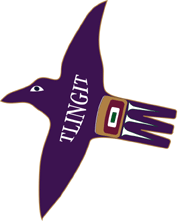 Tlingit Indians of Southeastern Alaska Tlingit Indians of Southeastern Alaska
Section 2: CLANS
5 days (1 week)
CONCEPTS: CLANS, HOUSES, CRESTS, STORIES, MATRILINEALITY,
MOIETIES
OBJECTIVES
- Students can identify Kahtahah's ethnic group and find her
village
- Students can state at least one function which Tlingit clan
crests serve
- Students can state how a child receives its clan membership
and can define "matrilineal"
- Students can define "moiety"
|
MATERIALS
- Native Peoples and
Languages of Alaska map
- Tongass National Forest map
- Kahtahah, (to be shared: one per two students)
- Northwest Coast Study Prints (UN 639)
- Northwest Coast Indian Art (Alaska State
Museum mini-kit)
- The Whale House of the Chilkat (Alaska State
Museum mini-kit)
- Enrichment: Films and units on art (see p. 73
for listing)
- How to Build a Canoe (enrichment)
- UN 597 (Traditional Alaska Native Transportation)
(Enrichment)
- The Tlingit World
- Butcher paper and marker
- In A Tlingit Winter House (Enrichment)
- Worksheets 3, and 6
(in pdf)
- LANGUAGE ARTS: See p. 78 for units and publications
- Worksheet 4 (optional-do
this or computer program)
- Computer Program: Tlingit Clans (optional
- do this or Worksheet 4) (Web-converter's
note: not available at time of conversion)
- Worksheet 5 (enrichment)
(in pdf)
- Moiety cards
|
PREPARATION
- Distribute Kahtahah to students (one for
every two students)
- Order Units 597 or 647 for enrichment activities
(optional)
- Duplicate Worksheets 3,
and 6
- Duplicate Worksheet 4
(optional)
- Prepare class for computer use and duplicate computer
program worksheet (optional) (Web-converter's
note: not available at time of conversion)
- Duplicate Worksheet 5
if
desired (enrichment)
|
ACTIVITIES
|
DAY 1
|
- Read and discuss Chapters I and II in Kahtahah
(pp. 1-5)
- Enrichment: canoe building
- Environment in Kahtahah's village
- Discussion on families
- Enrichment: In a Tlingit Winter House
- Enrichment: The Whale House of the Chilkat ART
ACTIVITIES: Clan Crests and Northwest Coast Style Art
|
|
DAYS 2 & 3
|
- Read and discuss Chapter 3
in The Tlingit World
- Produce and design clan crest banners or hangings
- Begin to write clan stories LANGUAGE
ARTS: Clan Stories
|
|
DAY 4
|
- Read and discuss Chapter 4, "Clans are Matrilineal",
in The Tlingit World
- Worksheet 3
- Computer Program: Tlingit Clans or Worksheet
4
- Enrichment Homework: "If My Family Were Matrilineal" Chart
(Worksheet 5)
|
|
DAY 5
|
- Go over Worksheet 5
- Chapter 5 in The Tlingit
World
- Worksheet 6
- Enrichment: Moiety Card Games
|
NEW VOCABULARY
Kahtahah
cedar
emblem
companion
stern
Leaf Moon Month
unison
venison
supernatural
paralyzed
matrilineal
relationship
moiety
Section 2: CLANS
DAY 1
CONCEPT: CLAN FUNCTION AND MEMBERSHIP
PREPARATION FOR KAHTAHAH
Explain to students that they will now begin to read about
a little Tlingit girl named "Kahtahah". Refer to the pronunciation
key and be sure students can pronounce her name.
Explain that Kahtahah was a girl almost one hundred years ago,
and that today her grandchildren are grown up with grandchildren of their own.
Have a student point to Wrangell on the Language map or the
Tongass National Forest map. Note to students that the Wrangell area
was traditionally the home of the Kiksadis, the Teey hittaans, the Kaach.aadees,
and the Naanyaa.aayees.
When Kahtahah was a child, Wrangell was not the large (pop.
1315) town it is today, but was only an Army fort and supply post for gold rushers
traveling up the Stikine River to the gold fields.
READ KAHTAHAH
Read pages 1-5 in Kahtahah.
(Note: some teachers have found the reading of Kahtahah
to be difficult for their students and have read the assigned chapters to them.
The texts should be shared by two students each, since your reading will probably
be done orally in class. Should a student wish to read portions of the book
not assigned in this unit's guide, encourage him or her to do so.)
Kahtahah Goes to Summer Camp
Material reprinted from
KAHLAHAH, (C) Copyright
1976 by William L. Paul
Sr., by permission of
Alaska Northwest
Publishing Company
Kahtahah was a little Tlingit girl who
lived in a village near the mouth of the Stikine (Stikheen. or muddy) River
of Southeastern Alaska. She lived with her foster mother and foster father.
Snook, the head chief of a great tribe.
One morning she was awakened when her
mother called out to her: "Kahtahah, wake up now! We are going to summer
camp today. The large canoe is already loaded, and the sun will soon be shining."
Kahtahah sat up in her nest of squirrel
robes and watched the women busily working around her. Some were packing food
in boxes, some were taking down wall skins and storing them in carved red cedar
boxes, and others were making bundles of clothing. All were talking and laughing
because they were happy to go to the summer camp for the salmon fishing season.

Kahtahah's foster mother brought her a small piece of
dried salmon. "Eat now." she said. "because who knows when
the men will stop for food? But tomorrow night well have fresh salmon."
DISCUSS READING
Note the pictures of Snook's canoes in Kahtahah. What
was painted on them? Relate the design to the clan crests the students have
used on their folders.
Discuss their size and carrying capacity. Estimate how long
they were. Point out the model of the canoe on Print #6 and the wooden bailer
on Print #4 of the Northwest Coast Study Prints (UN 639). Let students speculate
on the animals depicted on those two objects.

Kahtahah pulled on her moosehide moccasins
with the baby seal fur edging. Taking the salmon her mother gave her, she
ran
down to the beach, singing. "We are going to summer camp! We are going
to summer camp!"
Every family in the village was getting
ready to go to its own summer camp. Dogs and children were everywhere, and the
young men and slaves carried bundles down to the large, beautiful canoes, which
were lined up on the shore,  their
protective skin and mat coverings removed. Each canoe was made from a single
red cedar tree. Snook's canoes were painted with the Eagle design because Snook
belonged to the Wolf clan, which has the eagle for its emblem. Some of the young
men had their own canoes. their
protective skin and mat coverings removed. Each canoe was made from a single
red cedar tree. Snook's canoes were painted with the Eagle design because Snook
belonged to the Wolf clan, which has the eagle for its emblem. Some of the young
men had their own canoes.
Kahtahah ran to her foster father, a
tall fine-looking Indian, but no longer young. She was his constant companion,
and very dear to him. She stood quietly at Snook's side while his nephews brought
down the last of the bundles and the loading was finished. The door of the Great
House (where a chief lived with his family and the families of his sisters'
sons) was closed but not locked, and when the salmon run was over they would
return home to find that everything was just as they had left it. No Indian
would steal. The women, children and dogs got into the canoe. Snook helped Kahtahah
to her place near him in the stern of the largest canoe, and the young men pushed
it into the water. They leaped to their places and picked up their paddles.
Everyone laughed and shouted. Summer had come!
In an hour all of the canoes belonging
to the other Great Houses in the village were on the water and the winter village
was deserted.
The Trip to Summer Camp
They started early on a clear morning
in May, the Leaf Moon Month, just as the sun rose in a pink and yellow glow
from behind the sharp-pointed mountains of the mainland. Snook's summer camp
was two long days paddle away on one of the large islands toward the sea.
Kahtahah sat on a pile of blankets and
chewed slowly on her dried salmon. None of the men had eaten breakfast because
it was thought to be weak and womanlike to take food so early in the morning.
On each side of the canoe were three men dressed in gay blanket coats made from
Hudson's Bay blankets with striped borders. Kahtahah watched them dip their
paddles in unison, the drops of water from their paddles turning to silver in
the rising sun.
ENRICHMENT: CANOE BUILDING
The How to Build a Canoe booklet contained
as part of this unit describes the process involved in
making a Tlingit dugout canoe.See also
UN 597 (Traditional Alaska Native Transportation).

After traveling a long way across the
wide water, the canoes came to another island, and Snook steered close to shore.
Everyone stopped talking and the men dipped their paddles silently. A man in
the bow of the first canoe lifted his gun. They soon neared the mouth of a little
meadow creek. A small herd of deer-a buck, a doe and a small spatted fawn-came
across the meadow and down to the beach to lick the salt seaweed. 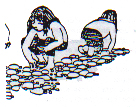 The
man with the gun gave a shrill whistle and the deer stopped, their heads up,
curious about the strange sound. The man shot. The buck leaped up, then fell
to its knees, dead. The mother deer pushed the fawn back to the shelter of the
trees and disappeared from sight by the simple trick of standing still. The
man with the gun gave a shrill whistle and the deer stopped, their heads up,
curious about the strange sound. The man shot. The buck leaped up, then fell
to its knees, dead. The mother deer pushed the fawn back to the shelter of the
trees and disappeared from sight by the simple trick of standing still.
The hunters killed just one deer because
they needed food only for the journey. Everyone in the canoe began to laugh
and talk, and Snook steered for the beach. The men jumped into the water and
pulled the canoe high on the shore for their breakfast of fresh venison. One
man began to skin the deer and others built a fire and unpacked the big cooking
pots. Kahtahah ran up and down the beach with the other children looking for
colored stones and shells.
The people gathered in a circle around
the pots, which were lifted off the fires when the boiled venison was ready.
Each person had a spoon made from a mountain sheep horn, so large that Kahtahah
could eat but one spoonful. Everyone was tired of dried salmon and greedily
ate the delicious stew.
When they had finished, bundles were
quickly loaded into the canoes and they were on their way again, not to stop
until they had reached the halfway point where they always camped overnight.
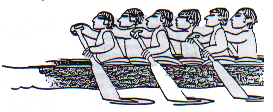
ENVIRONMENT IN KAHTAHAH'S VILLAGE
Have students search the book for references to the natural
environment. There are eight animals mentioned in pages 1 - 5 in Kahtahah.
Hold a timed contest between small groups of students (or make an untimed assignment)
in which students are to find all eight animals and identify how they are used
(when use is mentioned).
The animals and their uses are:
squirrel - robes for bedding
salmon - for breakfast (food)
moose - moosehide moccasins
seal - fur edging on the moccasins.
eagle - emblem
wolf - clan name
deer - food
dog - presumably pets (no function is mentioned)
DISCUSSION: FAMILIES
Turn to a consideration of Tlingit social structure, as depicted in Kahtahah.
Ask students what Snook's clan crest was.
Tell them that his clan name (though not given in the book yet) was Naanyaa.aayee.
Kahtahah refers to Snook's winter house, where Kahtahah
lived. Tell students that the house was a Naanyaa.aayee house, and Snook was
its headman or chief. All the adult men in the house were from the Naanyaa.aayee
clan. (Naanyaa.aayee women lived with their husbands in different houses, and
students will learn about that later.)
ENRICHMENT: In a Tlingit Winter House
Read the book to students, showing them pictures. See Appendix
B for a sample arrangement of clan members in a small cofiTnunity house.
Using
one of the "clans" in your classroom as an example, diagram on the
board the living arrangements of its members.
ENRICHMENT: The Whale House of the
Chilkat
(Alaska State Museum mini-kit)
This mini-kit can be obtained from your school library. It shows
one particular clan house, the Whale House of the Gaanaxteidee (also spelled
Gaanax.adee) of Klukwan.
Section 2: Clans
ART
ART
CLAN CRESTS AND NORTHWEST COAST STYLE
| 1. |
Refer to the teacher's guide contained in the Northwest
Coast Study Prints box (UN 639) for art activities. Your class will be
designing crest banners, and it would be helpful and appropriate at this
time to spend one or two art periods on Northwest Coast art.
See also Appendix E (p. 181)
for references on Northwest Coast art.
|
| 2. |
The following audiovisual materials show and talk about
Northwest Coast art:
F 427 The Loon's Necklace
F 2417 Legend of the Magic Knives
F 2575 Haida Carver
F 3665 Tlingit Ani
F 3825 Nathan Jackson: Tlingit Artist
F 4581 Richard's Totem Pole
UN 519 Tlingit Basketry
UN 624 Trade Beads and Beadwork of Alaska
UN 642 Far North Unit
UN 691 Tlingit Material Culture Slide Show |
DAYS 2 & 3
CONCEPTS: CLANS, HOUSES, CRESTS, AND STORIES
The next two days' activities will be in the disciplines of art
and language arts: the class clans will first be given a bit more background
on their crests and clan histories. They should then be given time to draw and
write their own emblems and stories.
CHAPTER 3 in The Tlingit World
Read Chapter 3 in The Tlingit World. Discuss the experiences
which led to clans obtaining their crests.
- What do they all have in conmion? (The supernatural
or magical is involved in them).
- Compare this aspect of the stories with the Athabascan
stories in When People Meet
Animals.
- What things can a person own in modern America? Can
a person own a story?
- Discuss copyrights on books and what they mean. If there
were no writing or books, how would a person's authorship of a story
be
proven?
- Why is it so important for a clan to own the exclusive
rights to its own story?

CHAPTER 3: CLANS, HOUSES, CRESTS, AND STORIES
By now you've gotten the idea that the Tlingit family
is not just a mother, father, and children. It is a much bigger group of
related
people called day "clan". The fourteen clans you've been introduced
to our only a fraction of the fifty or so clans throughout Tlingit territory.
CLAN HOUSES
You've learned that the members of a clan lived together
in a big house. A very big clan might have two, three, even six houses in a
single village. A smaller one would have just one clan house.
CLAN CRESTS
Another thing that you've learned is that clans have
crests which tell the rest of the world who they are, and a little bit about
their history. No clan can use another's crest. Snook's clan had the Eagle crest,
for instance. The crest decorates canoes, houses, clothing, totem poles, many
different belongings. But how did the clan get the right to use its crest?
CLAN STORIES
There is a story that tells about each crest design.
The story tells how a member of the clan (long, long ago) met with the crest
animal and had a sad, strange, supernatural, funny, or exciting experience with
it.  When
the person returned to his family and village, he told of the experience. Often,
he had been told by the animal that his clan can use its image from then on.
When the clan member recounted the story, he passed this permission onto his
relatives. When
the person returned to his family and village, he told of the experience. Often,
he had been told by the animal that his clan can use its image from then on.
When the clan member recounted the story, he passed this permission onto his
relatives.
The elders of each clan know their stories better than
anyone helps. If you are a Tlingit, you would not tell clan story unless it
was from your own clan. In fact, you would get into trouble if you told someone
else's story. The reason is this: the stories are the clan's history. They are
one of the most important bits of property the clan has. They are a kind of
commodity, more valuable than eulachon oil. If someone tells the stories wrong,
the true history will be lost.
Here are some examples of the kinds of experiences clan
members had with their crest animals:
 |
The Gaanax.adee (or Gaanaxteidee) woodworm
crest was obtained when the young woman of the clan kept a woodworm as a
child is ease her loneliness. |
| The Dekl'aweidee have the killerwhale as their main
crest. They got it when a man of the clan carved the first killerwhale out
of yellow cedar, after trying many other kinds of wood. |
 |
 |
The Wrangell Kiksadi frog crest was obtained when
the Kiksadi man kicked a frog and was instantly paralyzed. His spirit learned
from the frogs that they were of the Kiksadi clan also, and so he should
treat frogs well. |
These paragraphs do not tell the whole plan stories,
but they can give you an idea of types of stories that explain how clans got
their crests.
WRITE CLAN STORIES
Students' clans have, up to this point, been given names and
crest designs, and students will soon be making banners or hangings. At this
point they should meet to plan a clan presentation for a class-wide party or
potlatch. Each clan should make up its own clan story telling how it came to
have its crest design. Alternatively, if clan members have reada version of
the story which actually belongs to their Tlingit clan, they can learn this
story and prepare for its presentation.
Tell students that during clan ceremonies, or potlatches, each
clan presents itself, its crests, and sometimes its stories in a dramatic manner
(singing and dancing). In the absense of Tlingit music and dance instructors,
students can plan to present themselves and their stories by acting the parts
or presenting a puppet play.
Give students one day to begin writing the stories. Another
day to finish up is reconinended later in the unit (p. 140).
Section 2: Kahtahah
LANGUAGE ARTS
LANGUAGE ARTS
CLAN STORIES
Refer to Appendix I (pp. 245 ff.)
for recorded versions of a few Tlingit clan crest stories. Read the stories
to yourself, then rephrase them as you tell them to students.
If you have access to any of the following publications, you
might read one or more to your students during Language Arts time. Point out
that, in some cases, the clan elders were not involved in the recording or checking
of the stories, so these versions may be slightly wrong. Still, they are close
approximations of the stories.
UN 516 Tlingit Stories Kit
This unit contains a number of Tlingit stories, most of which
have been adapted from the incomparable Tlingit Myths and Texts by
John R. Swanton. It would be a good way to begin your study of Tlingit literature.
Davis, Henry, Keet-Kake Version
This is a paperback printed in-state a number of years ago.
It may be in your school library. It is about the origin of the Killerwhale,
and is a Dakl'aweidee story.
Ackerman, Maria, "The Girl and the Woodworm" from Tlingit Stories.
This is the Gaanax.adee story.
Garfield and Forrest, The Wolf and the Raven.
Many clan stories appear in this book.
See Appendix D, p. 179 for bibliographic
information on these books.
BANNERS OR HANGINGS
Each of the clans in your classroom should now make its own
banner or hanging to represent its main crest. The Northwest Coast Study Prints
should be displayed in your classroom.
You will need to designate areas within the classroom as home
areas (clan houses) for the various clans. It is there that the banners or hangings
should be displayed.
Directions for making crest designs for the houses follow:
1. BANNER:
Provide the clan with appropriate clan crest design (pp. 19-32
of this guide), a large sheet of paper, and paints, or markers, or colored paper
(red, black, white, blue, green, and yellow). The banner design may not have
the name of the clan on it, but it must have a picture of the clan's main crest
design. This design can occur once on the banner (students will need to
enlarge it from the 8 1/2 x 11 sheet that you give them), or can consist of
a series of repetitions of the design, each 8 1/2" x 11". The art
rules are as follows:
- Fill up all the spaces on the banner; leave nothing
blank. If there is a big undecorated space it can be filled with cross-hatching.
Creativity within the rules is encouraged.
- Use black for the outlines of the crest design.
- Use red, white, blue-green, or yellow for other parts
of the design.
- The design may be colored or colored papers can be glued
on.
2. HANGING REPRESENTATION:
Enlarge the appropriate crest designs found on pp. 19-32 of
this guide with the aid of an overhead projector. Give the enlarged (up to 3')
images to the clan groups. Eachgroup must cut out the design and an identical
shape to be used for the backing. The design is painted, colored, or glued together
(abide by the four rules described for BANNERS, above). The unpainted back is
stapled to the front around the edges, leaving an opening of about a foot along
one side. The figure is then stuffed with newspaper, paper towels, or scratch
paper, and then the opening is stapled shut. Attach a string to the top and
hang it in the clan's own area.
DAY 4
CONCEPT: MATRILINEALITY
TEXT: CHAPTER 4 IN THE TLINGIT WORLD
Read aloud or allow students to read silently Chapter 4, "Clans
are Matrilineal" in The Tlingit World,.
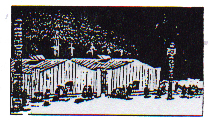
CHAPTER 4: CLANS ARE MATRILINEAL
Snook belonged to the Naanyaa.aayee (or
Wolf) clan, but Kahtahan did not.
Perhaps that seems strange to you. If you
father's last name is Johnson, then your last name is Johnson too. Shouldn't
Kahtahan's clan name be the same as her foster father's? Isn't a clan name like
a last name?
Not quite. In Tlingit culture, a child gets
its clan name from its mother. If the mother is a member of the Kiksadi clan,
then so are all of her children. It doesn't matter which clan the father belongs
to, because he doesn't pass that on to his children.
WORD STUDY
Ask students if they know other words with the root "matri" in
them. Have one or more students look for related words in the dictionary
(e.g., maternal, matriarch, matron, matrimony).
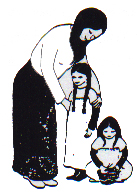 When
children get their names (or their clan membership) from their mothers, we
say
their culture is "matrilineal." That means the clan is passed through
the mother's ("matri") line ("lineal"). Is your family
matrilineal? When
children get their names (or their clan membership) from their mothers, we
say
their culture is "matrilineal." That means the clan is passed through
the mother's ("matri") line ("lineal"). Is your family
matrilineal?
COMPARISON
Compare the Tlingit matrilineal system with the one that determines
relationship in most American families today. That system is termed "bilineal"
or "bilateral," and recognizes relationship on both the mother's
and father's side. However, there is a bias toward patrilineality in most Euro-American
families, in that the father's name rather than the mother's is passed on to
children. You might add that since clan membership in Tlingit society is what
determines who your closest relatives are, and clan membership depends on the
mother, the Western system of taking the surname of the father has meant that
nowadays many very closely related Tlingits have different last names, and
that
many people who are only. distantly related in the Tlingit sense have the same
last name.
WORKSHEET 3
Do Worksheet 3 together as a class.
WORKSHEET 4 or COMPUTER PROGRAM
and COMPUTER PROGRAM WORKSHEET
Plan to do either Worksheet 4 or the computer program,
Tlingit Clans, with your class. The two are quite similar and so both
do not need to be done.
You will need to help students interpret Worksheet
4 before giving it to them. It can be an individual or small group activity.
The computer program is an individual activity. Provide copies
of the Computer Program Worksheet (p. 93), to use as they use the program.
WORKSHEET 5 (ENRICHMENT)
At this time assign Worksheet 5
as homework if you wish.
DAY 5
CONCEPTS: MATRILINEALITY, MOIETIES
WORKSHEET 5 (ENRICHMENT) HOMEWORK
If you assigned Worksheet 5 to
students, go over it with them. Make a new class name list using the students'
matrilineal names.
TEXT: CHAPTER 5 IN THE TLINGIT WORLD
Read Chapter 5, "Moieties: The Wolf and the Raven,"
in class. Most Tlingit and Haida children in your class will know their moiety,
even if they don't know their clan names. (Note: "moiety" comes from
a French word which means "middle" or "half".) Ask Tlingit
or Haida students in your class which moiety (more often referred to as "side"
or "tribe") they belong to. (Note: Tsimshian
society is not divided into moieties.)
CHAPTER 5: MOIETIES: THE WOLF
AND THE RAVEN
Every Tlingit belongs to a clan, which he
inherited from his mother. Kahtahah, for instance, belonged to the Teey Hit
Taan (of Frog) clan, just as her mother had.
Every Tlingit also belongs to something
called a "moiety" (pronounced moy' eh ty).
There are two moieties in the Tlingit culture,
and about half of the people belong to each one. The names of the moieties
are "Wolf" and "Raven." In the northern part of the Tlingit
area, the Wolf moiety is known as the Eagle moiety.
How can a person belong to a clan and a
moiety?
Each clan belong to one moiety or the other.
For instance, the Teey Hit Taan clan belongs to the Raven moiety. So, every
person who is a Teey Hit Taan is also a Raven. Kahtahah was a Raven.
Other clans also belong to the Raven moiety.
Some of their names are Kiksadi, Kaach.adee, Deisheetaan, Gaanax.adee.
Some clans belong to the Wolf or Eagle moiety.
Some of their names are Naanyaa.aayee (Snook's clan), Kaagwaantaan, Shangukeidee,
and Wooshketaan.
One reason a person's moiety is important
is because it tells whom a person can marry. In the old days, a Raven had to
marry a Wolf (or Eagle). If she married another Raven, it would be like marrying
her brother. This rule meant that a person's mother and father were always from
different moieties, and also from different clans. This way, different clans
stayed friends with each other because their members married each other. It
meant that even if a Tlingit's clan was athe Teey Hit Taan clan, he still had
some relatives in another clan, the clan that his father belonged to.
What moiety will Katahah's husband belong
to? What moiety will her children belong to?
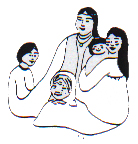
|
MOIETY
CLAN NAMES
|
RAVEN
TEEY HIT TAAN
KIKSADI
KAACH.ADEE
DEISHEETAAN
GAANAX.ADEE
T'AK DEINTAAN
KWAASHK'IKWAAN
ISHKANITTAAN
SUKTEENEIDEE
|
WOLF OR EAGLE
NAANYAA.AAYEE
KAAGWAATAAN
SHANGUKEIDEE
WOOSHKETAAN
CHOOKANEIDEE
TEIKWEIDEE
YANYEIDEE
TSAAGWEIDEE
DAKL'AWEIDEE
|
|
DISCUSSION: MOIETIES
After you have read "The Wolf and the Raven" in class,
discuss the concept. Write "Raven" and "Eagle or Wolf" on
the board. Write the names of your class clans under the appropriate heading.
Explain that, in addition to clan crests, the students are permitted to use
their moiety crests as well. (If all clans in your classroom are from the same
moiety, write the clan names from the other 4th grade class (presumably they're
the opposite moiety) in the appropriate column). Emphasize the main importance
of moieties: that a person must marry someone from the opposite moiety. Discuss
how this rule might help unify Tlingit society.
WORKSHEET 6 (p. 96)
A quick review of the concept of moiety can be achieved through
Worksheet 6. Fill the worksheet in as a class and
have students put it in their folders.
ENRICHMENT: MOIETY CARD GAMES
The moiety cards can now be used to illustrate the concept of
moiety and the rule that Tlingits must marry members of the opposite moiety.
A number of different card games can be played using these cards. Two are described
below; invent other games as you like. Choose the games which best suit your
class.
1. Concentration: Played by 2 to 6 students. Place
all cards face down on the table. One player turns over a card. He notes
the
clan and moiety written on the card, shows it to the other players, then turns
over another card which he hopes is of the opposite moiety. If it is, he
can
keep both cards: he has a "marriage." He gets another turn. If it
is of the same moiety, even if it is of a different clan, both cards must be
placed face down in the same location they were originally and another player
gets a turn.
2. Go Fish: Played by 3 to 5 students. Shuffle and
deal 5 cards per player. The object is to make marriages by collecting cards
of opposite
moieties. First player asks a specific player to "Give me all your (names
a specific clan name) cards." When the player is given the card asked for,
she may ask the same or a different player for another card. When no one can
provide her with the card she asks for, she draws a card from the deck and another
player has a turn. Whenever a player has two cards of opposite moieties, she
has a "marriage" and places them aside. (They may be of any two clans,
as Tong as the moieties are different.) The winner is determined when all cards
have been used up and the players count the number of marriages they have put
aside. High count wins.
Worksheet 3 (in pdf)
Worksheet 3 Answers (in
pdf)
Worksheet 4 (in pdf)
Worksheet 4 Answers (in
pdf)
Tlingit Clans Computer Program
Worksheet (in pdf)
Tlingit Clans Computer Program
Worksheet Answers (in pdf)
Worksheet 5 (in pdf)
Worksheet 6 (in pdf)
Worksheet 6 Answers (in
pdf)
TABLE OF CONTENTS
MATERIALS LIST & GOALS
SECTION 1: Tlingit
Country
SECTION 2:
Clans
SECTION 3: Summer
Camp
SECTION 4: Tlingit
Economy: Surplus
SECTION 5: Wrap
Up
APPENDIX A: Brief
Description of Tlingit Culture
APPENDIX B: A Sample
Winter Clan House
APPENDIX C: Northwest
Coast Materials in ASD AVS Center
APPENDIX D: Juvenile
Literature on Northwest Coast Cultures
APPENDIX E: Art
Bibliography
APPENDIX F: Northwest
Coast Cultures Bibliography
APPENDIX G: Schools
Which Own Northwest Coast Study Prints
APPENDIX H: Raven
Stories (reprints)
APPENDIX I: Recorded
Versions of Clan Crest Stories
APPENDIX J: Some
Northwest Coast Art Activities
|